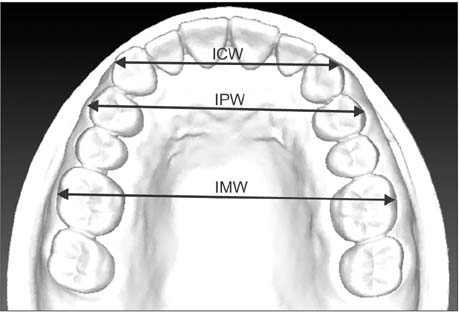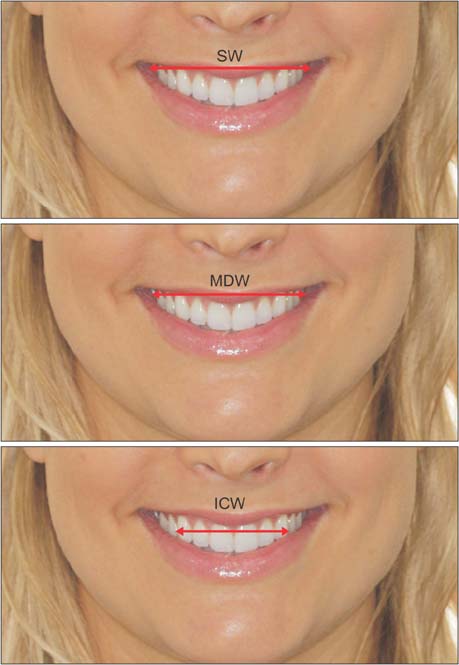Korean J Orthod.
2017 Mar;47(2):100-107. 10.4041/kjod.2017.47.2.100.
Smile esthetics: Evaluation of long-term changes in the transverse dimension
- Affiliations
-
- 1Department of Orthodontics, Tufts University School of Dental Medicine, Boston, MA, USA. sercan.akyalcin@tufts.edu
- 2Private Practice, Queensbury, NY, USA.
- 3Department of Orthodontics, School of Dentistry, University of Texas Health Science Center, Houston, TX, USA.
- 4Private Practice, Arlington, TX, USA.
- KMID: 2400387
- DOI: http://doi.org/10.4041/kjod.2017.47.2.100
Abstract
OBJECTIVE
To analyze the long-term changes in maxillary arch widths and buccal corridor ratios in orthodontic patients treated with and without premolar extractions.
METHODS
The study included 53 patients who were divided into the extraction (n = 28) and nonextraction (n = 25) groups. These patients had complete orthodontic records from the pretreatment (T1), posttreatment (T2), and postretention (T3) periods. Their mean retention and postretention times were 4 years 2 months and 17 years 8 months, respectively. Dental models and smiling photographs from all three periods were digitized to compare the changes in three dental arch width measurements and three buccal corridor ratios over time between the extraction and nonextraction groups. Data were analyzed using analysis of variance tests. Post-hoc multiple comparisons were made using Bonferroni correction.
RESULTS
Soft-tissue extension during smiling increased with age in both groups. The maximum dental width to smile width ratio (MDW/SW) also showed a favorable increase with treatment in both groups (p < 0.05), and remained virtually stable at T3 (p > 0.05). According to the MDW/SW ratio, the mean difference in the buccal corridor space of the two groups was 2.4 ± 0.2% at T3. Additionally, no significant group × time interaction was found for any of the buccal corridor ratios studied.
CONCLUSIONS
Premolar extractions did not negatively affect transverse maxillary arch widths and buccal corridor ratios. The long-term outcome of orthodontic treatment was comparable between the study groups.
Keyword
Figure
Cited by 1 articles
-
A systematic review of the accuracy and efficiency of dental movements with Invisalign®
Lidia Galan-Lopez, Jorge Barcia-Gonzalez, Eliseo Plasencia
Korean J Orthod. 2019;49(3):140-149. doi: 10.4041/kjod.2019.49.3.140.
Reference
-
1. Ioi H, Nakata S, Counts AL. Effects of buccal corridors on smile esthetics in Japanese. Angle Orthod. 2009; 79:628–633.
Article2. Martin AJ, Buschang PH, Boley JC, Taylor RW, McKinney TW. The impact of buccal corridors on smile attractiveness. Eur J Orthod. 2007; 29:530–537.
Article3. Zange SE, Ramos AL, Cuoghi OA, de Mendonça MR, Suguino R. Perceptions of laypersons and orthodontists regarding the buccal corridor in long- and short-face individuals. Angle Orthod. 2011; 81:86–90.
Article4. Chang CA, Fields HW Jr, Beck FM, Springer NC, Firestone AR, Rosenstiel S, et al. Smile esthetics from patients' perspectives for faces of varying attractiveness. Am J Orthod Dentofacial Orthop. 2011; 140:e171–e180.
Article5. Parekh SM, Fields HW, Beck M, Rosenstiel S. Attractiveness of variations in the smile arc and buccal corridor space as judged by orthodontists and laymen. Angle Orthod. 2006; 76:557–563.6. Ioi H, Kang S, Shimomura T, Kim SS, Park SB, Son WS, et al. Effects of buccal corridors on smile esthetics in Japanese and Korean orthodontists and orthodontic patients. Am J Orthod Dentofacial Orthop. 2012; 142:459–465.
Article7. Ghafari JG. Emerging paradigms in orthodontics-an essay. Am J Orthod Dentofacial Orthop. 1997; 111:573–580.8. Spahl TJ. Premolar extractions and smile esthetics. Am J Orthod Dentofacial Orthop. 2003; 124:16A–17A. author reply 17A.9. Johnson DK, Smith RJ. Smile esthetics after orthodontic treatment with and without extraction of four first premolars. Am J Orthod Dentofacial Orthop. 1995; 108:162–167.
Article10. Kim E, Gianelly AA. Extraction vs nonextraction: arch widths and smile esthetics. Angle Orthod. 2003; 73:354–358.11. Gianelly AA. Arch width after extraction and nonextraction treatment. Am J Orthod Dentofacial Orthop. 2003; 123:25–28.
Article12. Yang IH, Nahm DS, Baek SH. Which hard and soft tissue factors relate with the amount of buccal corridor space during smiling? Angle Orthod. 2008; 78:5–11.
Article13. Akyalcin S, Erdinc AE, Dincer B, Nanda RS. Do long-term changes in relative maxillary arch width affect buccal-corridor ratios in extraction and nonextraction treatment? Am J Orthod Dentofacial Orthop. 2011; 139:356–361.
Article14. Meyer AH, Woods MG, Manton DJ. Maxillary arch width and buccal corridor changes with orthodontic treatment. Part 1: differences between premolar extraction and nonextraction treatment outcomes. Am J Orthod Dentofacial Orthop. 2014; 145:207–216.
Article15. Janson G, Branco NC, Fernandes TM, Sathler R, Garib D, Lauris JR. Influence of orthodontic treatment, midline position, buccal corridor and smile arc on smile attractiveness. Angle Orthod. 2011; 81:153–161.
Article16. Krishnan V, Daniel ST, Lazar D, Asok A. Characterization of posed smile by using visual analog scale, smile arc, buccal corridor measures, and modified smile index. Am J Orthod Dentofacial Orthop. 2008; 133:515–523.
Article17. Sarver DM, Ackerman MB. Dynamic smile visualization and quantification: part 1. Evolution of the concept and dynamic records for smile capture. Am J Orthod Dentofacial Orthop. 2003; 124:4–12.
Article18. Sarver DM, Ackerman MB. Dynamic smile visualization and quantification: part 2. Smile analysis and treatment strategies. Am J Orthod Dentofacial Orthop. 2003; 124:116–127.
Article19. Dahlberg G. Statistical methods for medical and biological students. London, UK: Allen and Unwin Publishing;1940. p. 122–132.20. Bishara SE, Cummins DM, Jakobsen JR. The morphologic basis for the extraction decision in Class II, division 1 malocclusions: a comparative study. Am J Orthod Dentofacial Orthop. 1995; 107:129–135.
Article21. Saelens NA, De Smit AA. Therapeutic changes in extraction versus non-extraction orthodontic treatment. Eur J Orthod. 1998; 20:225–236.
Article22. Francisconi MF, Janson G, Freitas KM, Oliveira RC, Oliveira RC, Freitas MR, et al. Overjet, overbite, and anterior crowding relapses in extraction and nonextraction patients, and their correlations. Am J Orthod Dentofacial Orthop. 2014; 146:67–72.
Article23. Maulik C, Nanda R. Dynamic smile analysis in young adults. Am J Orthod Dentofacial Orthop. 2007; 132:307–315.
Article
- Full Text Links
- Actions
-
Cited
- CITED
-
- Close
- Share
- Similar articles
-
- Total intrusion and distalization of the maxillary arch to improve smile esthetics
- VERTICAL DIMENSION : A LITERATURE REVIEW
- Factors affecting smile esthetics in adults with different types of anterior overjet malocclusion
- Functional and esthetic improvement through systematic diagnosis and treatment procedures in patient with unaesthetic anterior teeth proportion because of tooth wear: A case report
- Microsurgical Approach for Root Coverage of Receding Gingiva in the Esthetic Zone





